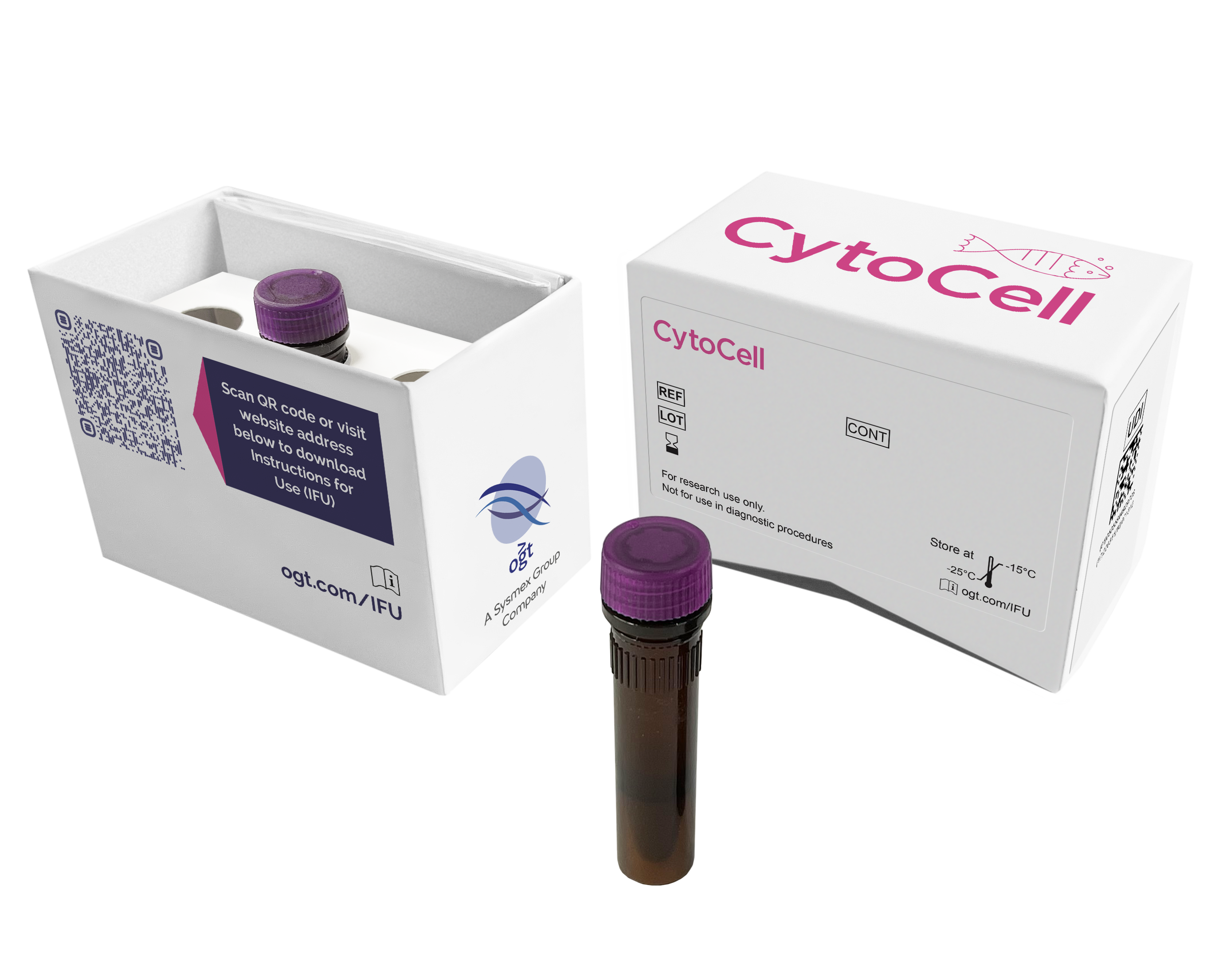
The ROS1 Plus probe consists of 3 probes (175kb, 123kb, 184kb), labelled in green, situated proximal to the ROS1 gene and including markers D6S2428 and SHGC-149552 and a red probe (206kb) covering the distal part of the ROS1 gene and a region up to RH78348.
The ROS1 (ROS proto-oncogene 1, receptor tyrosine kinase) gene at 6q22 is an ALK (anaplastic lymphoma receptor tyrosine kinase) gene paralogue which encodes a type I integral membrane protein with tyrosine kinase activity1.
ROS1 rearrangements define a molecular subset of non-small cell lung cancer (NSCLC) and are seen in approximately 2% of patients with NSCLC2. A number of partner genes have been identified, including SLC34A2, CD74 and SDC43. It has been shown that these ROS1 fusions activate the pSTAT3, PI3K/AKT/mTOR and SHP-2 phosphatase pathways4,5.
NSCLC patients with ROS1 rearrangements have been shown to respond to treatment with ALK/MET tyrosine kinase inhibitors, such as crizotinib6.
ROS1 rearrangements with the GOPC (golgi associated PDZ and coiled-coil motif containing) gene fusion partner were originally reported in glioblastoma, but have now also been detected on cholangiocarcinoma, ovarian cancer and NSCLC patient samples7-9.
The ROS1 Plus design covers the ROS1 region and the region deleted in ROS1-GOPC fusions.
In vitro diagnostic (IVD)
→ English/Français/Italiano/Deutsch/Español
→ Polski
Research use only (RUO)
→ English
Find certificate of analysis documentation for our CytoCell FISH probes

Our lab has been using a wide range of CytoCell FISH probes for a number of years, and have been increasing this range all the time. The probes have clear bright signals and show good reproducibility. CytoCell provides fast delivery of catalogue probes, and are very responsive when we have any queries or problems with their products.

Bridget Manasse
Addenbrookes Hospital, Cambridge University Hosiptals NHS Foundation Trust, UK
In our hands, CytoCell FISH probes have proven to be of the highest quality with bright, easy to interpret signals, thus providing confidence in our results. OGT's customer support is outstanding, as their staff are extremely knowledgeable and truly care about their customers and their customers’ needs.

Jennie Thurston
Director of Cytogenetics, Carolinas Pathology Group, USA
I first came across CytoCell FISH probes in a previous lab I worked in and I was struck by the quality of the products. Since this time, I have been recommending and introducing CytoCell probes across all application areas — now they are the primary FISH probes used in our lab. They have an excellent range of products and their ready-to-use reagent format saves considerable time.

Elizabeth Benner
Medical Technologist, University of Arizona Health Network, USA
We have been working with CytoCell fish probes for two decades because of their excellent clarity and intensity regardless of the size of the probe. It is so clear and simple to detect.
Dr. Marina Djurisic
Head of Laboratory of Medical Genetics, Mother and Child Health Care Institute of Serbia “Dr Vukan Cupic”, Serbia
The quality and consistency of CytoCell’s probes means I can trust the results, and my clients get their results in a timely manner.

Dr. Theresa C. Brown
Director, Cytogenetics Laboratory, Hayward Genetics Center, Tulane University School of Medicine, USA
It was very important for us to have more consistent results with our probes — easy-to-read bright signals and a range of vial sizes, which is much more cost-effective.

Janet Cowan, PhD
Director of the Cytogenetics Laboratory, Tufts Medical Center, USA
Not only do CytoCell offer an extensive range of high-quality FISH probes, the customer support is also excellent — providing fast access to all the probes I need. The probes are highly consistent with bright signals allowing easy scoring of results.
Dr. Eric Crawford
Senior Director, Genetics Associates Inc., USA
The quality and reproducibility of results using the CytoCell kit has been vital in accurately detecting co-deletions in our glioma investigations. We now have a cost-effective test that we can rely on that is also easy to use and interpret. We've been consistently impressed with this kit - not to mention the support offered by OGT's customer service, and have completely transitioned over to CytoCell probes.
Gavin Cuthbert, FRCPath
Head of Cancer Cytogenetics, Northern Genetics Servce, Newcastle, UK